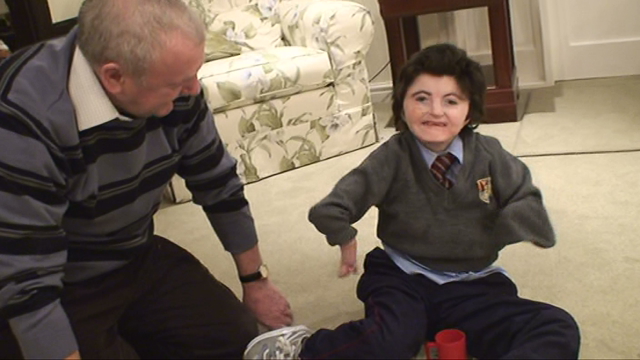Social Skills
Research conducted by the Cerebra Centre has focused on three particular areas of behaviour that are important for our understanding of sociability: social interaction skills (the tools to engage with others), social enjoyment, and the motivation to engage in social interaction with others.
Social interaction skills
Researchers at the University of Birmingham have found many individuals with Cornelia de Lange syndrome have some difficulties understanding and using the ’tools’ for social interaction.
These ’tools’ include the use of eye contact, facial expression, following another’s gaze and other non-verbal skills including showing, pointing, giving and gesturing.
When children and adults with Cornelia de Lange syndrome were observed across a range of social situations, many of the children and adults were extremely ‘passive’ during social interaction with both familiar and unfamiliar people, and rarely initiated interaction.
In this video you will see Tamsin and Jo interacting. Jo takes the lead in this interaction.
These difficulties in social interaction skills are similar to those observed in individuals with autism spectrum disorder. Further research is required to determine the extent of these similarities. Please see the section on autism spectrum disorder for more detailed information.
Social enjoyment
It is difficult to say how much a person with Cornelia de Lange syndrome will enjoy social interaction with others. This will depend very much on the individual and no two individuals with Cornelia de Lange syndrome are the same.
Social interaction skills may be limited, however, many children do enjoy engaging with other people. At the top of this page you can see Ursula interacting with her father. However, it is important to remember that this might occur only in particular situations or settings and may be largely on the individual’s own terms. Individuals may rely heavily on others to structure the interaction.
Some of the children that were observed in the research project at the University of Birmingham showed enjoyment of basic social play (peek-a-boo and tickling games).
Other children and adults actively avoid social interaction with others, moving away from the adult, pushing them away or turning their head or face away from them.
Other children and adults that we observed appeared to enjoy engaging with others but showed signs of feeling uncomfortable, anxious and self-conscious during interaction with unfamiliar people. These characteristics may reflect the presence of social anxiety in some individuals.
Social motivation/desire for social interaction/sociability
Compared to other individuals with intellectual disability, individuals with Cornelia de Lange syndrome scored at a similar level to individuals with fragile X syndrome (a syndrome known to be associated with social anxiety) on a questionnaire measure of sociability.
The only group of individuals who scored below those with Cornelia de Lange syndrome on this measure of sociability were those with autism spectrum disorder, for which impairments in social interaction and social motivation are core diagnostic criteria.




